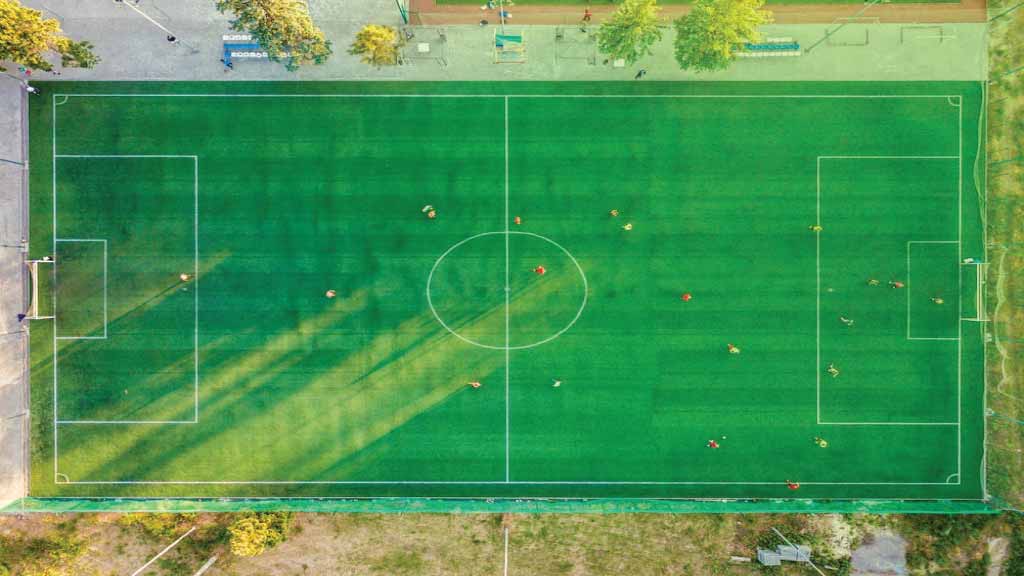A standard soccer field, also known as a football pitch, varies in size depending on whether it’s used for professional or amateur matches. However, according to FIFA regulations, the dimensions typically fall within a specific range. For international matches and professional leagues, the length of the field typically ranges from 100 to 110 meters (approximately 110 to 120 yards), while the width ranges from 64 to 75 meters (approximately 70 to 82 yards).
On the other hand, for amateur and youth games, the field dimensions may vary slightly, but they generally adhere to similar proportions. These variations aim to accommodate players of different ages and skill levels while maintaining the integrity and spirit of the game.
The soccer field is marked with several lines that serve different purposes. The boundary lines, also known as touchlines, delineate the edges of the field. Meanwhile, the goal lines mark the ends of the playing area and determine scoring opportunities. Positioned in the center of each goal line is the goal, consisting of two upright posts connected by a crossbar.
In addition to the boundary lines and goal lines, the soccer field features markings to designate various zones and areas. The halfway line divides the field into two equal halves, with each team defending one half and attacking the other. At the center of the halfway line lies the center circle, which is used for the kick-off to start the game and restart play after a goal is scored.
Near the corners of the field are corner arcs, which are used for corner kicks. When the ball goes out of play over the goal line, but not between the goalposts, the opposing team is awarded a corner kick. The kicker places the ball within the corner arc before taking the kick, allowing teammates to position themselves strategically in the penalty area in an attempt to score.
The penalty area, also known as the 18-yard box, is a critical area on the soccer field. It extends 16.5 meters (approximately 18 yards) from each goalpost and is 40.3 meters (approximately 44 yards) wide. Within the penalty area is the penalty spot, which is located 11 meters (approximately 12 yards) from the goal line. This spot serves as the location for penalty kicks, awarded when a foul is committed by the defending team within the penalty area.
Surrounding the penalty area is the larger rectangular area known as the penalty area. This area extends 16.5 meters (approximately 18 yards) from each goalpost and is 40.3 meters (approximately 44 yards) wide. It serves as the location for goal kicks, awarded to the defending team when the ball goes out of play over the goal line but is last touched by the attacking team.
In summary, a soccer field provides a regulated and standardized playing surface for the game of soccer. Its dimensions, markings, and zones are carefully designed to facilitate fair and exciting gameplay while accommodating players of various ages and skill levels. Whether it’s the thrill of a professional match or the camaraderie of an amateur game, the soccer field serves as the stage for the beautiful game to unfold.
Related FAQs:
What are the dimensions of a standard soccer field?
Answer: The dimensions of a standard soccer field typically range from 100 to 110 meters (approximately 110 to 120 yards) in length and 64 to 75 meters (approximately 70 to 82 yards) in width, adhering to FIFA regulations for professional matches.
What is the purpose of the penalty area on a soccer field?
Answer: The penalty area, also known as the 18-yard box, is a critical zone on the soccer field. It extends 16.5 meters (approximately 18 yards) from each goalpost and serves as the location for penalty kicks, awarded when a foul is committed by the defending team within this area.
How are corner kicks awarded in soccer?
Answer: Corner kicks are awarded when the ball goes out of play over the goal line, but not between the goalposts, and is last touched by the defending team. The attacking team then takes the kick from within the corner arc near the corner of the field, providing an opportunity to create scoring chances.
What is the significance of the center circle on a soccer field?
Answer: The center circle is a key marking on the soccer field located at the midpoint of the halfway line. It is used for the kick-off to start the game and to restart play after a goal is scored, serving as a focal point for players to gather and initiate gameplay.
How are penalty kicks awarded in soccer matches?
Answer: Penalty kicks are awarded when a foul is committed by the defending team within the penalty area. The kick is taken from the penalty spot, located 11 meters (approximately 12 yards) from the goal line. It offers the attacking team a direct scoring opportunity with only the goalkeeper to beat.

